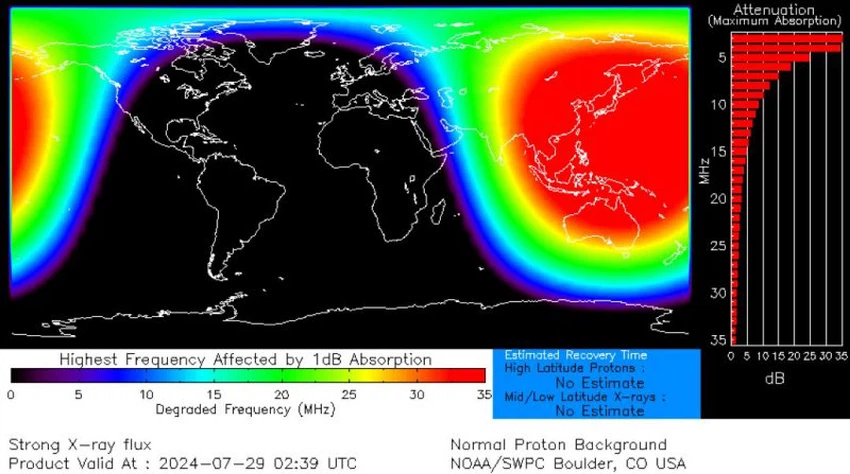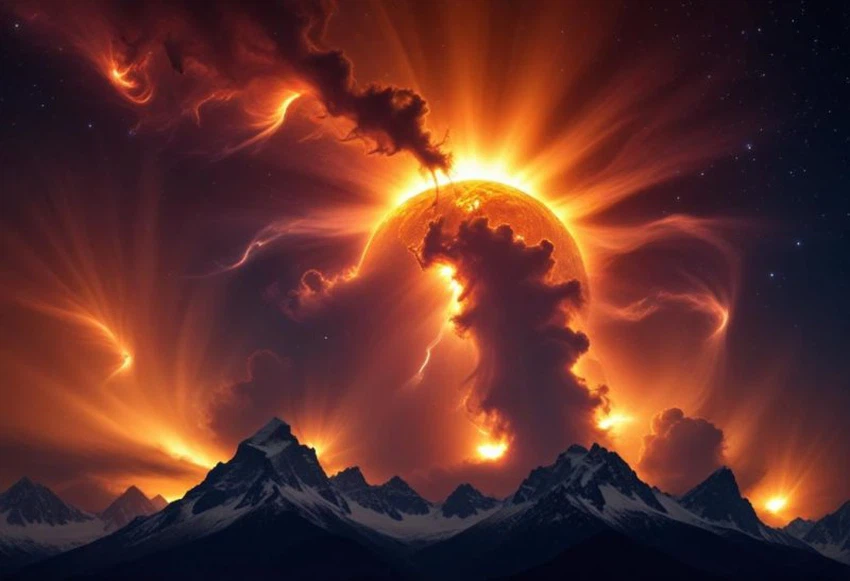A strong solar storm is coming to Earth.. How will it threaten communications?
Arabia Weather - from July 30 to August 1; A series of coronal mass ejections (CMEs) will occur, and many CMEs are expected to reach Earth and lead to increased geomagnetic activity during this period. It is expected to begin arriving on July 30 , and its presence could lead to strong geomagnetic storm conditions and auroras at mid-latitudes.
Activity is likely to be greatest on July 30, which could lead to G2-G3 levels, as indicated by the WSA-Enlil model.
You may also be interested in:

Activity forecast for the coming days
The effects of a coronal mass ejection are expected to continue until July 31, as it takes some time for a coronal mass ejection to advance above the Earth, past it. However, a coronal mass ejection continues to emanate from the Sun; Due to the number of active regions and the complex sunspot clusters associated with them. This increases the likelihood of solar flares, and M-class flares (R1-R2; minor to moderate) are now expected during most days of the week, with a slight chance of X-class flares (R3; strong).
Alerts have been issued for geomagnetic storm levels according to expectations:
- G3 on July 30
- G2 on July 31
If forecast conditions occur during the late evening hours, the aurora could occasionally become visible as far south as the northeastern United States across the upper Midwest, and across the rest of the northern states to include northern Oregon.
G1-G3 Watches are out for 29-31 July due to a number of possible CME arrivals. Solar activity increased over the weekend and the Sun has been erupting in solar flares up to include an X1 flare (R3-Strong) on Sunday evening. Visit https://t.co/9VAtkQeOwM ... for the full story. pic.twitter.com/3VNJJ9CRgM
— NOAA Space Weather Prediction Center (@NWSSWPC) July 29, 2024
Solar flare effect
Solar flares are explosions from the surface of the Sun that release intense bursts of electromagnetic radiation. These flares occur when magnetic energy accumulated in the solar atmosphere is suddenly released.
Radiation from solar flares reaches Earth at the speed of light, ionizing the upper atmosphere upon arrival. This ionization creates a denser environment for high-frequency shortwave radio signals that facilitate long-distance communication. However, when these radio waves interact with electrons in the ionized layers, they lose energy due to increased collisions, which can cause the radio signals to decay or be completely absorbed.
-
Classification of solar flares
Solar flares are classified by size into different categories, with Class X flares being the strongest and Class M flares being ten times less powerful than Class X, followed by Class C flares, which are ten times weaker than Class M. Class B flares are ten times weaker Class C, Class A flares are ten times weaker than Class B flares and have no noticeable effect on the ground.
Each category is also divided by numbers from 1 to 10 (and later for X-class flares) to indicate the relative strength of the flare. The solar flare was measured on 28/29 July X1.5 according to Space Weather Live, when it erupted from sunspot area 3764.

Impact of solar storm on communications
Class Earlier this year we saw several powerful flares.
The source of the May 10 massive solar storm, which produced a visible aurora in all 50 US states for the first time in decades, was sunspot AR3664.
A few days after the longest solar storm to hit Earth, the giant spot moved to face Mars, according to an image taken by NASA's Perseverance rover from its location inside Jezero Crater on the surface of Mars on May 15, 2024.
It is worth noting that on May 14, the giant Carrington sunspot AR3664 released a solar flare with a magnitude of According to NASA computer models, the jet reached Mars on May 17 and caused increased aurora activity there.
See also:
Sources:
National Oceanic and Atmospheric Administration
space.com
Browse on the official website